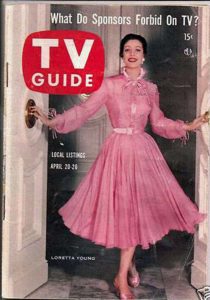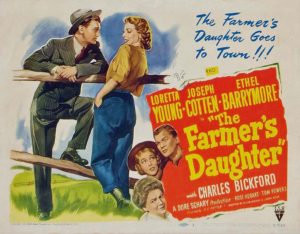Loretta Young’s death on Aug. 12, 2000 prompted this remembrance published in The Kansas City Kansan (Crum on Film) on Aug. 18, 2000.
 By Steve Crum
By Steve Crum
Loretta Young was a salvation for my sister and me throughout most of our pre-school through grade school years. Young’s death on Aug. 12 (at 87) reminds me that when Sunday evening rolled around, our baths finished, it was 9 o’clock bedtime. “But Mom, can’t we just stay up until Loretta Young is over?” This weekly plea invariably ended with my madre (who made decisions in matters of this magnitude) giving in. The dialogue was repeated week after week, year after year, during The Loretta Young Show’s sturdy 300 episode run, 1953-61.
To be truthful, in the beginning it could have been the New York Stock Market Report for which we pled. We just needed an excuse to stay up later. Mom realized our ploy, but knew that the show afforded us learning through entertainment. And that it did. We quickly grew to love it. The Loretta Young Show, thanks in full to its namesake, featured half hour stories of human compassion. It was an uplifting and inspiring series as well as class production. Young starred in a majority of the episodes, playing a challenging gamut of roles. Her three Emmys and two Golden Globes are testament.
 Loretta Young has long forbade that her old series be rerun, due to the fact that each episode begins with her showcasing what was then a chic dress as she twirls through her entrance door to greet the home audience. She thought that modern audiences would laugh at the way she was dressed. Maybe so. More likely the black and white filming might turn some audiences away. Then again, Perry Mason, I Love Lucy and The Fugitive reruns are still strong draws. Quality is the key, and the endurance of Young’s series is evident within the handful of video tape copies that are commercially available. (By the way, during the first broadcast year, the show was entitled Letter to Loretta. Young would read an actual viewer’s letter, and tie it in to the evening’s program.)
Loretta Young has long forbade that her old series be rerun, due to the fact that each episode begins with her showcasing what was then a chic dress as she twirls through her entrance door to greet the home audience. She thought that modern audiences would laugh at the way she was dressed. Maybe so. More likely the black and white filming might turn some audiences away. Then again, Perry Mason, I Love Lucy and The Fugitive reruns are still strong draws. Quality is the key, and the endurance of Young’s series is evident within the handful of video tape copies that are commercially available. (By the way, during the first broadcast year, the show was entitled Letter to Loretta. Young would read an actual viewer’s letter, and tie it in to the evening’s program.)
 Growing up, and thanks to TV again, I discovered that Loretta Young was also a movie star. There was the film in which she played Sister Margaret in the moving Come to the Stable (1949), for which she was Oscar nominated. In the Christmas classic, The Bishop’s Wife (1947), Young dealt with heavenly Cary Grant. Her 105 movies were varied in plot and characterization. For example, Young could play light comedy brilliantly, as she did in her Oscar winning role as Swedish farm girl-turned-congresswoman in 1947’s The Farmer’s Daughter. She sparred with Gary Cooper in the comedy-western, Along Came Jones (1945); and in a more romantic way dealt with suitors William Holden and Robert Mitchum in the delightful Rachel and the Stranger (1948).
Growing up, and thanks to TV again, I discovered that Loretta Young was also a movie star. There was the film in which she played Sister Margaret in the moving Come to the Stable (1949), for which she was Oscar nominated. In the Christmas classic, The Bishop’s Wife (1947), Young dealt with heavenly Cary Grant. Her 105 movies were varied in plot and characterization. For example, Young could play light comedy brilliantly, as she did in her Oscar winning role as Swedish farm girl-turned-congresswoman in 1947’s The Farmer’s Daughter. She sparred with Gary Cooper in the comedy-western, Along Came Jones (1945); and in a more romantic way dealt with suitors William Holden and Robert Mitchum in the delightful Rachel and the Stranger (1948).
From small child roles in 1917 silent movies (she was born in 1913), to her last work as narrator in 1994’s TV movie Life Along the Mississippi, Loretta Young earned her film star  status. She was also one of the very first successful TV stars to embrace the new medium in place of continuing a big screen career.
status. She was also one of the very first successful TV stars to embrace the new medium in place of continuing a big screen career.
The great actress, born Gretchen Michaela Young, positively impacted fans via TV and movies for more than 70 years.
On a personal note, she helped me lose a half hour’s sleep every Sunday night of my youth. I am forever thankful.
